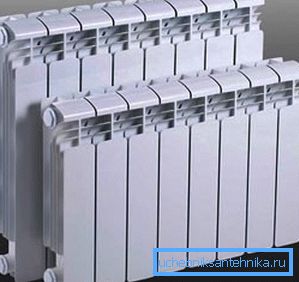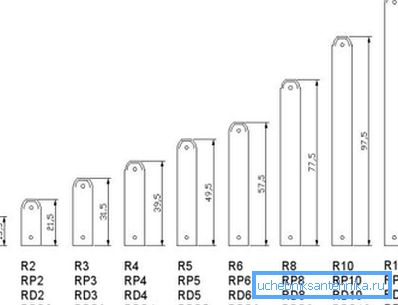Heating radiators: dimensions and heat output
The size of a heating radiator is one of the basic parameters that determines the performance of this device. That is why, choosing batteries for installation in an apartment or house, we need to pay attention not only to the material from which they are made, but also to their dimensions.
In our article we will consider the most important aspects of this choice, as well as analyze the dependence of the size of the radiator and its heat performance.

Product Description
Battery configuration

The dimensions of radiators directly depend on their design. And although the general scheme of the device battery is almost always the same, the differences are still present.
According to this parameter, such groups of products are distinguished:
- Sectional. The most common type of heating devices. The design consists of several separate modules that can be interconnected in any number.
Note! The instruction manual for sectional radiators often contains the characteristics (heat transfer, mass) not of the entire product, but of a separate section. This approach greatly facilitates all thermal calculations.
- Tubular. Outwardly, they are quite similar to sectional ones, but they have a complete structure. The fins of such radiators are represented by metal tubes, inside which hot water or another coolant circulates. They are characterized by a fairly high price, but at the same time they are the most efficient heating devices.
- Panel. Represent several pipes with coolant, enclosed in a metal casing. Usually they have compact dimensions in order to facilitate their installation in small-sized typical apartments.
It should be noted that the configuration largely determines the material that is used for production. So, sectional models are made either from cast iron or aluminum, and for the most part of panel devices they use steel. As for tubular radiators, they can also be steel, but copper models are considered to be the most productive among specialists.

Dimensions of the main varieties
As we noted above, the size of the heating device determines how much heat it will transmit to the air in the room. However, most manufacturers produce products in different dimensions: as a rule, in the standard, compact (low) and enlarged version. This diversity allows you to select a battery for specific requirements both in terms of heat and location.

Note! The features of the mounting point impose certain restrictions on the maximum size of the construction used, but we will talk about this in the section dedicated to the installation of the installation by hand.
Below is a table that you can use to determine the size of the most part of the used types of radiators:
| Material | Parameter | Standard models, mm | Low models, mm | Tall models, mm |
| Cast iron (sectional) | Height | 588 | 388 | 660 - 955 |
| Depth | 140 | 140 | 140 | |
| Section size | 93-95 | 93-95 | 93-95 | |
| Steel (panel) | Height | 600 | 150 - 500 | 750 - 1200 |
| Depth | 70 - 150 | 70 - 150 | 70 - 150 | |
| Panel width | 400-3000 | 400-3000 | 400-3000 | |
| Aluminum (sectional) | Height | 580 | 200 - 400 | 700 |
| Depth | 75 -100 | 75 -180 | 80 -100 | |
| Section size | 80 | 40 | 80 | |
| Steel + Aluminum (bimetallic sectional models) | Height | 550 - 580 | 300 - 500 | up to 900 |
| Depth | 75 -100 | 95 | 95 | |
| Section size | 80 | 80 | 80 |

Note! This table shows the averaged parameters. The size of heating radiators from different manufacturers may differ quite strongly, because if it is critical for you to match the dimensions to a millimeter, you should study the features of a particular model in advance, and it is better to measure your chosen copy with a tape measure.
Installation Recommendations
Thermal power calculation
If we analyze the information from the manufacturer, then it becomes obvious that devices of different sizes emit different amounts of heat into the room. It is for this reason that you need to count the number of sections or heating panels only after you have chosen a model for installation.

The calculation itself is quite simple:
- Heating 1 cubic meter of living space requires 41 watts of energy. Consequently, the required battery performance will increase in proportion to the size of the room.
- Thus, the volume of the room 5 x 5 x 3 m will be 75 m3.
- For heating, we will need 3075 watts.
Perform the calculation for the most commonly used types of radiators:
- Pig-iron heating radiators with an average heat dissipation of 120 W / section - 26 sections.
Note! We got a fractional number - 25.6 - so we round it up.
- Steel heating radiators (140 W) - 22 sections.
- Aluminum heating radiators (180 W) - 17 sections.
- Bimetallic radiators (200) - 14 sections.
Naturally, if we use devices with increased height, then their heat output will be much higher. Accordingly, the number of sections required for space heating will decrease.
Correct installation

In addition to the actual heat transfer performance, the size of the heating radiator, which we acquire for our house, will also depend on where we install it.
- So, for installation along the walls and under windowsills with a height of 90 cm or so, standard battery models are usually purchased. In sectional devices, the width is adjusted by adding edges, and panel and tubular products must be initially selected depending on the dimensions we need.
- High varieties can be used on loose walls. As a rule, they are characterized by increased heat dissipation, and therefore they are usually mounted in large rooms with an excess of open space.
- The use of compact radiators with low profile will be justified in the corridors and hallways, as well as in houses with large window openings.
With regard to specific numbers, you should adhere to the following restrictions:
- To ensure unimpeded intake of cold air to the radiator for heating, the device must not be mounted close to the floor. The minimum gap is about 60 mm, and the optimum - 100 - 150 mm.
- The same applies to the distance from the top edge of the battery to the window sill. In order for the hot air to freely penetrate the room, the gap between these elements must be at least 100 mm.

Note! If you are using a dimensional model, then in the window sill itself you need to make holes for the release of warm air, decorating them with special grids. By the way, the installation of such gratings can partially solve the problem of condensate formation on glasses due to their heating.
- It is desirable to select the width of the radiator so that it covers almost the entire window opening (at least 75 - 80% of the distance from the slope to the slope). In this case, the device will have enough power to form a so-called thermal curtain that prevents the appearance of drafts.
Conclusion
Choosing the size of heating radiators, you must first pay attention to their compliance with the task that stands before the heating system of the room. As you can see, in the process of selecting and installing batteries there are a number of subtleties, so before you start purchasing and installation work, you should view the video presented in the article for more information.